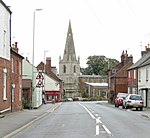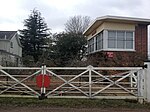Bosworth Hall (Husbands Bosworth)

Bosworth Hall actually consists of two houses, the Old Hall and a newer Georgian-style hall, situated in Theddingworth Road, Husbands Bosworth, Leicestershire. The Old Hall, originally constructed in Norman times, was substantially renovated in the 16th century as a west facing country house. The new and additional Georgian hall was then built facing south west, adjoining the older house, in about 1790. In about 1870 a Victorian Gothic wing was created to link the two buildings. The whole is a Grade II* listed building. The older Tudor house has two storeys with attics in a range of five gables. Some traces of the original Norman construction can be seen in the present building. A 19th century wing to the left added a sixth gable to the frontage. To the south the 1870 wing created the link to the three-storey, five-bay Georgian house.
Excerpt from the Wikipedia article Bosworth Hall (Husbands Bosworth) (License: CC BY-SA 3.0, Authors, Images).Bosworth Hall (Husbands Bosworth)
Theddingworth Road, Harborough Husbands Bosworth
Geographical coordinates (GPS) Address Nearby Places Show on map
Geographical coordinates (GPS)
| Latitude | Longitude |
|---|---|
| N 52.4536 ° | E -1.049 ° |
Address
Theddingworth Road
Theddingworth Road
LE17 6NL Harborough, Husbands Bosworth
England, United Kingdom
Open on Google Maps










